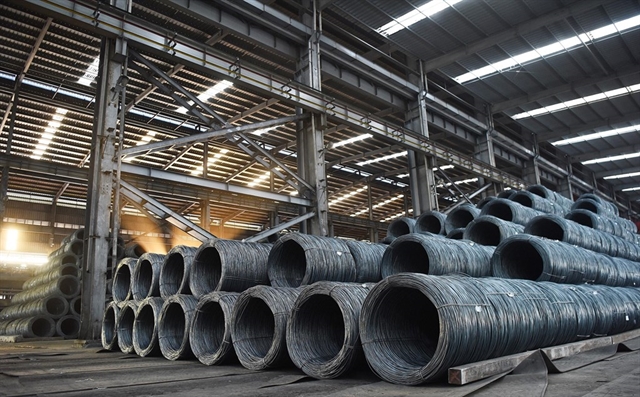
HÀ NỘI — Steel prices have been steadily on the decline in the last few weeks as prices for raw materials dropped on the global market, according to the Vietnam Steel Association (VSA).
VSA reported prices for iron ore have gone down to US$139 per tonne, a $16 decrease from prices at the beginning of April, and a $71-73 decrease from the record-breaking prices reported in May 2021 at $210-212 per tonne. Meanwhile, prices for steel scrap have also seen a significant drop to $530 per tonne, a $94 decrease from early April. Hot-rolled coil has fallen to $797 per tonne, an $81 decrease.
Since the beginning of the year, demand for steel in the domestic market has been high as economic recovery was in full swing. Steelmakers, taking full advantage of robust demand, also raised their prices on the pretext of higher input costs of imported raw materials.
However, a sharp fall in demand in China due to extensive social distancing measures employed by Chinese authorities in recent months has forced Vietnamese steelmakers to lower prices to clear their inventory, bringing steel down to an average of VNĐ18.25-18.50 million per tonne.
Hòa Phát steel has gone down by VNĐ4.6-8.0 million per tonne, Việt Đức steel by VNĐ5.1-7.6 million, Thái Nguyên steel by as much as VNĐ8.1 million per tonne.
According to owners of metal stores in Hà Nội, while steel has gone down from its over-VNĐ20 million per tonne mark in March, it remained quite high compared to the end of 2021. Recent price drops have not managed to bring steel down to the previous price level after four consecutive price hikes since the beginning of the year.
Vietnamese steelmakers together produced more than 11.4 million tonnes of steel during the first four months of 2022, a 2 per cent increase from the same period last year. Of which, 10.6 million tonnes were sold, a 4 per cent increase year-on-year with 2.5 million tonnes exported.
According to the VSA, for the time being, Vietnamese makers were able to meet all domestic demand. However, the country could only supply 20-30 per cent of raw materials, making Vietnamese steel prices largely dependent on the global market.
By the association’s estimate, Việt Nam will have to import as much as 18 million tonnes of iron ore, and 6.5 million tonnes of scraps and coking coal in 2022.
In the short run, cheaper steal would mean the country’s much-needed infrastructure projects could now progress with less pressure from soaring material prices, of which steel alone typically accounted for 20-30 per cent. VNS
- Reduce Hair Loss with PURA D’OR Gold Label Shampoo
- Castor Oil Has Made a “Huge” Difference With Hair and Brow Growth
- Excessive hair loss in men: Signs of illness that cannot be subjective
- Dịch Vụ SEO Website ở Los Angeles, CA: đưa trang web doanh nghiệp bạn lên top Google
- Nails Salon Sierra Madre
 VnExpress News The News Gateway of Vietnam
VnExpress News The News Gateway of Vietnam




